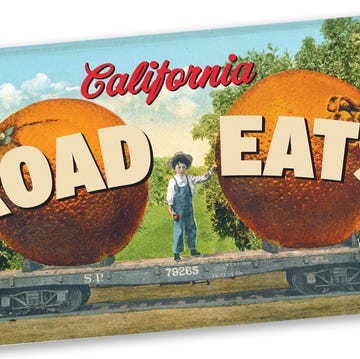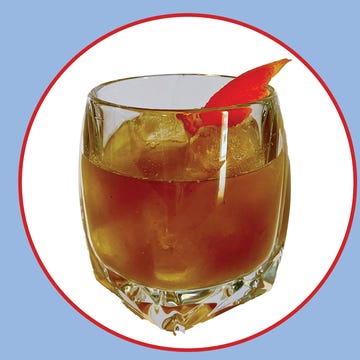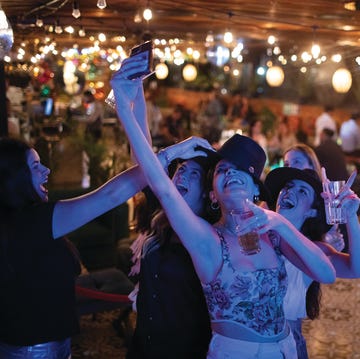The House That Beans Bought sits in the Mayacamas Mountains above Sonoma and Napa Counties, on eight acres of sloped forest and a pond brimming with croaking frogs. It’s a former Seventh-Day Adventist church, now converted into the superego of Steve Sando.
Sando is the founder and owner of Rancho Gordo, the Napa-based food company credited with making luscious heirloom beans cool. Sourced from across the world—Italy, India, the South, but especially Mexico—Sando’s beans are must-have ingredients in American pantries, gourmet and otherwise. Falstaffian in build and brio, with a scruffy gray beard and tortoiseshell-framed glasses, Sando has branded himself equal parts Johnny Appleseed and James Beard: He’s an apostle for the nutritional and cultural value of his legumes, but also for their fun.
Who else could create an MCU out of…beans?
This article appears in Issue 31 of Alta Journal.
SUBSCRIBE
Tan-and-white Yellow Eye beans colored like a Texas longhorn. Black Caviar lentils as dark and earthy as their name. Ivory-white Marcellas, purple-speckled Cranberries. Beans as small as a pinkie nail (flageolets) or as wide as a thumb (California Coronas).
There’s the Bean Club, whose 26,000 lucky members receive six one-pound bags of beans (and another Rancho Gordo product) every quarter, while 22,000 unlucky souls on the waiting list get an occasional coupon for free shipping as a thank-you for their patience. There’s the cute flagship store in a residential Napa neighborhood, decorated with the greatest hits of Sando’s collection of golden age–era Mexican-film posters, one of the largest of its kind in the world. And tying the community together is a breezy fortnightly newsletter that includes recipes with gorgeous photos and dispatches by Sando on his interactions with customers, whom he alternately refers to as bean buddies or People of the Bean.
“My goal wasn’t to get in every grocery store in the country, because I knew it’s still in this niche situation,” Sando told me in the spring of last year as we sat in his living room. A wooden cabinet held first editions of Mexican books and vintage pewter silver from Mexico—shot glasses, bowls, artwork. Other art around us leaned toward classical ennui. Bultos (wooden statues) of Catholic saints, all with agonized faces. Portraits of the Infant Jesus and Mary. In the room where my wife, our (now late) Chihuahua Hook, and I slept for a couple of days on that visit, there were more paintings stacked on the floor and against the wall like the CD boxes and books next to them.
“But I got to do it myself, which has been a very hard but satisfying road,” he continued. “And I know I’m rambling, but I think imposing my taste on other people is really great. I love showing people who maybe love canned beans or frozen dinners or don’t think they have options, like, ‘Oh, you can do this, and let me show you how—we’ll do it together.’ ”
He stopped and offered a small, satisfied smile.
“And that’s always been my attitude. And that has been how I’ve moved.”
Steve Sando might be America’s bean king, but to my wife and I, he’s a compa—a dear friend. He and Delilah first hit it off eight years ago, when she placed her first Rancho Gordo order for her store, Alta Baja Market in Santa Ana. Every fall, the market hosts the Heirloom Bean Encuentro, a three-day Rancho Gordo happening—think Drag Queen Bean Bingo, bean monologues, Mexican wine and mezcal tastings, and more, all leading to a five-course bean supper featuring Michelin-starred and James Beard Award–nominated chefs.
Delilah and I spent two nights at Sando’s house last spring for business: There was a literal ton of beans for us to pack into our Yukon at Rancho Gordo’s warehouse in Napa and drive back 450 miles to Alta Baja. Delilah and Sando had to talk about the upcoming Encuentro. And he and I needed to do something Sando loathes to do: reflect.
“You can’t rest, you know?” he said at one point during our two-hour conversation. He quoted his dad: When you’re coasting, you’re going downhill. “And it totally stuck with me my whole life. And I think it’s actually made me not be able to relax too often. But it is true. You shouldn’t coast. But sometimes, you have to coast for a little while.”
Sando is as charming and joyous in private as he is in public, but Delilah and I know a different side: emo. He’s 65, and he knows that time is running out on his Rancho Gordo era. “I’m thinking about ‘What is my exit strategy?’ ” he admitted early on in our chat. “But it’s…what’s her name? Alberta Hunter, the blues singer.”
He let a beat pass. “She said, ‘There’s a lot of tunes left in an old violin.’ ”
Even at nine in the morning for breakfast at his home, dressed in cargo shorts and a short-sleeve shirt after a night of too much mezcal with Delilah and me, Sando carried himself with an air of tousled regality. He’d made us grilled shrimp and chicken with bayo beans left over from the night before, now simmered in chicken stock and a fragrant chile sauce. Slightly smaller and paler than pintos, Rancho Gordo’s rich, velvety bayos are limited to Bean Club members.
Man, Delilah and I told Sando, you’re really treating us like royalty! But he described his spread as “mediocre,” which provoked the first of many reprimands to stop selling himself short that my honey and I gave him during our time together. Sando jotted down the details of our previous night’s dinner in a notebook with a fountain pen—a tradition he’s kept for 15 years—as we scarfed down our breakfast. Boleros and jazz standards ebbed and flowed on a stereo. A gas-powered generator whirred outside—the power was out.
I suggested that Sando elaborate on something he’d told us about the night before: the offers he’s receiving from big companies I can’t divulge here to sell Rancho Gordo.
It ain’t happening.
He mentioned two sisters who work for him.
“What am I supposed to tell them—like, ‘Oh, we’re going to move this all to Vegas. You could get a crappy job in Vegas if you go, and they’re going to let you go as soon as they don’t need you’? It was like, no. I feel a real responsibility to them and to the community.”
He paused. “I want this to be the best place to work anywhere.”
Sando’s desire to take care of those around him—friends, 35 full-time employees, customers—comes from a lifetime of trying to prove himself…to himself.
Born in Los Angeles but raised around the Bay Area, Sando grew up with parents who divorced when he was eight and masked their turmoil with jazz- and alcohol-filled soirées that left Sando “smelling like gin, cigarettes, and steak” in the morning. His father was a “huge dreamer” who worked as a Disney animator before moving his young family up north so he could work in the field of computers. Then just before Sando enrolled at Tamalpais High in Mill Valley, his father was found guilty of embezzlement, which eventually forced the family to go on welfare.
“I just felt like the grown-ups disappointed me constantly,” Sando said. “And as soon as I was in control, I would be OK.”
He traveled the world—four months in India the summer before his senior year, jobs in England and Italy after high school—before returning to the Bay Area and becoming a “serial entrepreneur,” achieving enough success to make a living but nothing that left him satisfied. Then around the time Sando turned 40, he had a forced epiphany after learning that his maternal step-grandfather had willed his fortune—which Sando had expected to get some of—to his nurse.
“Finally, it got to me,” he said. “This isn’t working. You tried radio. You tried self-publishing, you tried music licensing, and you even tried web design. And I thought, ‘You know what? I can’t keep doing this.’ And I almost made it each of those times, so I thought, ‘You’re a fuckup.’ ”
With money from his late father’s life insurance policy, Sando and his then-wife moved to a two-acre property in Napa with their two young sons. He grew cherry tomatoes for his own amusement and enjoyed some of that initial harvest one balmy evening with his then-infant son.
“I’ve got this life sitting on my lap in his diapers, and he can’t even talk yet,” Sando remembered. We had moved from the dining table to a couch and recliner (he sat in the latter). “He ravaged it, and he’s got little tomato seeds all over his tummy. And I thought, ‘OK, I have to figure out how to make this work.’ ”
Sando moved on from tomatoes after growing a small crop of Rio Zape beans—a pinto variety cultivated by the Hopi—that he found in a seed catalog. He loved their chocolaty taste and purple hue. One harvest became two; 1 type of bean became 10. Sando had tried to sell his tomatoes at the Napa farmers’ market but wasn’t allowed in (“politics,” he says), so he set up a bean table at the Yountville farmers’ market next to “the lavender people.” His only customers in those early days were “old people who would ask me about beans that they ate during the Depression” and “old hippies who were…horrified” at what he charged.
Then one day in 2003, chef Thomas Keller of the French Laundry showed up.
It validated his efforts, Sando said, because he believed that previous customers had bought his beans “out of sympathy, or asked me about the beans out of sympathy, because it’s like, ‘You’ve got this loser product.’ And then Keller—I still remember him leaning in and saying, ‘What you’re doing is very important.’ And I thought, ‘I think so too!’ ”
Soon, all of Keller’s restaurants in Yountville were using Rancho Gordo beans, which the chef hails the company for selling “new”—that is, harvested, dried, and sold within a year instead of being allowed to sit for long. That, Keller wrote to me in an email, “provides the most consistent quality I have ever come across.” Keller’s restaurants have continued to serve Sando’s beans to this day.
The wins haven’t stopped since Keller’s visit. Online sales starting in 2005. A book in 2008. A new headquarters in 2010, along with Sando’s move to his mountainside estate because his life became too social. There were trips to Mexico to form partnerships with farmers to grow Rancho Gordo’s beans, as well as other heirloom Mexican food products, like dried xoconostle (the fruit from a particular kind of prickly pear cactus) and even banana vinegar from a family farm in Veracruz. Profiles in the New Yorker and on CBS News Sunday Morning raised Rancho Gordo’s national profile. The company has enjoyed 15 to 25 percent growth every year since its start.
But as we continued to talk, I was struck by how wary Sando was of success. At one point, I even suggested that he puts on airs of frivolity so he doesn’t have to reckon with all the good he’s done. “Yeah, I’m super uncomfortable with that.”
But why? “That I don’t know. If I were in therapy, I probably could try.”
You’re on the proverbial couch, I countered. He laughed. We continued. Then toward the end, he allowed himself some credit.
“Seriously, I’m making a difference,” he said. “So I’m pretty satisfied. My script really in my head was to be a movie star or something. The reality was like, ‘OK, you actually are a fuckup. This isn’t going to work.’ So to have the script completely flipped has been…I’m not sure how to deal with that necessarily.”
“You’re still dealing with this?” I asked incredulously.
“I think I am.”
That afternoon, Sando drove Delilah and me to a Rancho Gordo bean dinner hosted by Valley Swim Club, a buzzy restaurant in Sonoma. We went downhill—but he never coasted.
His 2018 Honda Accord—the one with the Rancho Gordo bumper sticker that proclaims “Every Pot a Victory”—zipped through hairpin turns and groves blackened by the 2017 Tubbs Fire, which went right up to his property line. On the way down, we heard a smoky version of the Nat King Cole classic “I’m Gonna Laugh You Right Out of My Life.”
The singer? Sando. If he channels Margo Channing in his day-to-day speech, in his singing style he veers more toward Mel Tormé: full-throated and joyous, with a dash of melancholy to keep listeners hooked. Sando’s not sure what to do with Rancho Gordo yet, but he wants to record more jazz albums—he’s done three already.
For now, he’ll go wherever the People of the Bean need him.
“You ask for this in a way, so you have to show up,” he said. “But I always have a fear no one’s going to come.” He recalled a birthday party of his to which only one child came. “I’ve had weird party anxiety since.”
We had barely parked at Valley Swim Club when Katherine Couture, a Bean Club member from Sonoma, rushed toward him.
“You make me so happy!” she exclaimed while embracing him. “I’m floating!”
It was a hot Sonoma day, but Sando—wearing olive slacks and a rumpled white guayabera accentuated by a silver jaguar pin inspired by the Florentine Codex—didn’t break a sweat. For three hours, he went from table to table, signing books and taking selfies with fans and chatting up Rancho Gordo to people who’d never heard of it.
“It’s less about his relationship with restaurants and more about his relationship with everyone else,” said Valley Swim Club co-owner Laura Feldman. She hosted Rancho Gordo’s 20th-anniversary party at Valley’s sister restaurant, Valley Bar + Bottle Shop, also in Sonoma. “He cares about them. He’s right in it. That’s how I feel.”
I accompanied Sando as he approached diners. Adriana Plascencia and Karen Pearson shared a table overlooking a huge field. “Are you Bean People? You have that look!” he told them as they grinned.
Plascencia, a native of Guadalajara, hadn’t heard of Rancho Gordo beans until she was served a dish of them that very evening. “I love them,” she said, gesturing to her frijoles mixtos—ayacote morados, vaqueros, and Christmas lima beans dressed simply but deliciously with roasted tomatoes, parmesan cheese, and olive oil.
“I always delete newsletters, but not yours,” said Pearson, a Bean Club member. “The only bean I didn’t like of yours was Corona,” a reference to the huge white beans that take hours to prepare. “They were so off.”
“It’s our number-one seller,” he said. Then he grinned. “Try them again!”
A bean hater? I had never seen Sando have to deal with one ever. But he graciously nodded his head and didn’t hesitate to respond.•
Gustavo Arellano is the author of Orange County: A Personal History and Taco USA: How Mexican Food Conquered America. In 2025, Arellano was named a Pulitzer Prize finalist for his work as a columnist for the Los Angeles Times. He was formerly editor of OC Weekly, an alternative newspaper in Orange County, California, and penned the award-winning ¡Ask a Mexican!, a nationally syndicated column in which he answered any and all questions about America’s spiciest and largest minority. Arellano is the recipient of awards ranging from the Association of Alternative Newsweeklies Best Columnist to the Los Angeles Press Club President’s Award to an Impact Award from the National Hispanic Media Coalition, and he was recognized by the California Latino Legislative Caucus with a 2008 Spirit Award for his “exceptional vision, creativity, and work ethic.” Arellano is a lifelong resident of Orange County and is the proud son of two Mexican immigrants, one of whom came to this country in the trunk of a Chevy.














